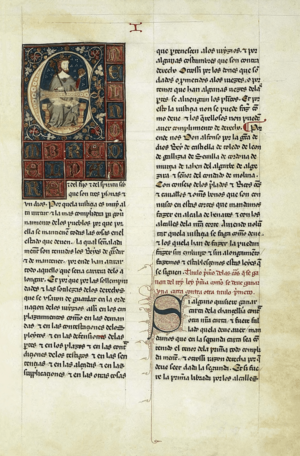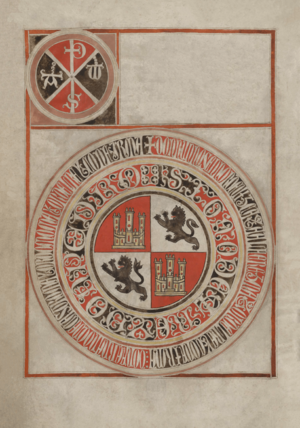Ordenamiento de Alcalá facts for kids
The Ordenamiento de Alcalá was a very important set of 58 laws made in 1348. King Alfonso XI and his court created these laws in a town called Alcalá de Henares in Spain. These laws became a key part of the legal system for the Castilian Crown (the kingdom of Castile) during the late Middle Ages. They were used for a long time, until new laws called the Leyes de Toro came out in 1505.
Before these laws, there were many different rules and customs in different places, which made things confusing. The king wanted to make the laws clearer and stronger across his kingdom. This was also a big win for the lawyers of that time. They knew a lot about Roman law and helped the king make his power stronger, aiming for a more absolute monarchy (where the king has most of the power).
Contents
What the Laws Included
Besides creating new rules, like those about fines, the Ordenamiento de Alcalá also set up a clear order for how different laws should be used. This was very important because there were many old laws and local rules.
Order of Laws
The Ordenamiento de Alcalá said that judges should follow laws in this order:
- First, they should use the new laws from Alcalá.
- Next, they could use the Fuero Juzgo (a very old law code) and local fueros (special laws for certain towns or regions).
- After that, they could use the Siete Partidas (a large collection of laws written earlier).
- Finally, if there were still questions or no clear rule, the king's advisors would help decide.
Where the Laws Were Used
The Ordenamiento de Alcalá was meant to be used in many areas, even those with their own local fueros. Over time, many places in Castile and León, like Sahagún and Cuenca, started to use these new laws or the Fuero Real, which was similar.
Challenges from Nobles
However, the king couldn't just make all the rules. Powerful nobles (rich landowners) wanted to keep their special rights and lands. These nobles had gained a lot of power during the many fights and civil wars of the Middle Ages. This was especially true when King Alfonso XI was a child, and his grandmother María de Molina and father Fernando IV were in charge.
The nobles reminded the king of old agreements, like one from 1138. They managed to keep many of their special tax and legal rights. They also kept their lands under their own control. Most importantly, they made sure they were recognized as ricoshombres. These were very powerful nobles, clearly different from regular knightly nobles or other free people.
Over time, the kingdom of Castile became divided into two main types of land:
- Royal lands: These were directly under the king's control and laws.
- Lordly lands: These were controlled by powerful nobles (either lay people or church leaders) who had their own rules.
How Long the Laws Lasted
The rules set by the Ordenamiento de Alcalá were used for a very long time. Many of its ideas were included in new law books during the Modern Age (from the 1500s onwards). These laws stayed important and were followed faithfully until Spain created its modern Código Civil (Civil Code) at the end of the 1800s.
See also
 In Spanish: Ordenamiento de Alcalá para niños
In Spanish: Ordenamiento de Alcalá para niños



